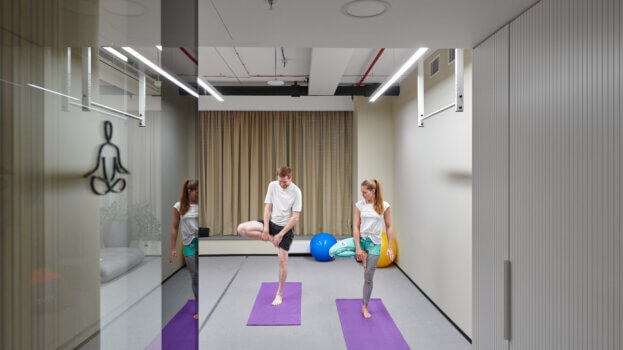Months of home-working have turned us into techies. We meet online, we call, write and share documents on digital platforms, and we create projects in the cloud. But while we could spend all day in joggers on the sofa – the most successful hybrid working environments do have rules – the hybrid etiquette. Eva Vavráková, Strategy Lead for Origameo, shares 16 of the most important ones.
- To email or video conference? That is the question
Different people prefer different tools. But certain tasks demand certain tools too. Ask in advance how colleagues would like to communicate, of course. But always make your own feelings known – spending hours on Zoom can burn you out.
In terms of activity, if the task is time-sensitive – use your phone. If it’s not, send an email, but stick to this simple rule: if the matter isn’t resolved after three messages, pick up the phone or book a video conference.
- Make it easy to join meetings
For remote meetings, be sure to include all the details in the invitation: a link to the meeting, all the passcodes and, importantly, a list of participants.
If you’re meeting in person, remember not everyone might be in. Check with each participant to see if they can make it.
- Make sending agendas top of your agenda
While most video conferencing software lets you share your screen, it helps when you have the files yourself – in case of slow connections as well as preparation. Make sure you send agendas and important materials well ahead of your meetings. They’ll also be in one email for you to open before you begin.
- Don’t make people wait
Whether in the office or online, it’s rude to be late to a meeting. If you’re running late, tell participants as early as possible. Always turn on your camera at the beginning of an online meeting at a minimum and make it a “hybrid working etiquette rule”.
- Test your tech
If you’ve arranged a meeting, it’s your job to make sure it goes smoothly. Make sure you’re free 10-15 minutes before it starts to check any microphones, cameras and other devices are working.
If the meeting involves a lot of tech, for example people are using a mix of devices or connections, be sure to book an IT support colleague to join the meeting.
- Start meetings with the camera on
When you start a video conference, make sure that your camera’s on. This face-to-face moment helps to build trust and a sense of teamwork.
If you’re speaking to people you don’t know well, like new colleagues or business partners, leave the camera on as much as possible, ideally throughout the meeting.
We all know by now how tiring it is spending all day on video calls. So if you’re speaking to close colleagues, feel free to switch off cameras after a few minutes – and turn them on again at the end to say goodbye.
- Look at the camera
Eye contact is an important element of communication, including when you’re on a video call. If your camera’s on, look your partner in the eye – by looking directly at the camera.
Don’t make the mistake of watching the eyes of the person speaking on the other side, or gazing at the discussion in the application’s chat panel. This makes your partner feel they don’t have your complete attention.

Eye contact is an important element of communication, including when you’re on a video call. If your camera’s on, look your partner in the eye – by looking directly at the camera.
- Mute if you’ve nothing to say
Unwanted background sounds can be distracting during meetings – and can potentially block a speaker’s microphone. Even if you’re in a quiet space, make sure you’re on mute if you’re not likely to speak for a while.
- Dress for the occasion
We all like to wear more comfortable clothes when we work from home. But while it’s tempting to slip on your favourite band t-shirt, keep your colleagues in mind. Choose the right clothing for the meeting – and dress more smartly when it’s appropriate.
- Be in the room
Surveys show that most people multitask during online meetings – reading emails, writing messages and more.
Try to avoid doing this. Make sure you’re in the room – virtually – by focusing properly on the work activity, keeping your phone out of reach, and turning off your notifications.

Surveys show that most people multitask during online meetings – reading emails, writing messages and more. Try to avoid doing this
- Give everyone space to speak
You’re in a meeting room with a colleague, and they start a sentence at the same moment as another colleague who’s dialling in. Who carries on speaking?
It’s always easier to focus on the person in front of you. Be aware of this bias and use conversational strategies to reach out and listen to any colleagues working remotely. They’ll get more involved in the project or topic, will be more open with their thoughts, and feel that their opinions are valued.
- Press pause on long meetings
Long sessions in front of a monitor can cause ‘virtual fatigue’. If your meeting lasts over 45 minutes, consider taking a break – a five-minute recess can help everyone refocus and come back with the energy to be more efficient and effective.
- Share minutes ASAP
The sooner you share minutes of meetings, the more likely the notes will be fresh in participants’ minds. Be sure to include clear plans that everyone understands and any next steps they need to take.
It helps to share them in the video conference platform’s chat panel – especially when you have regular meetings using the same codes as all the minutes will be in one place.
Dressing for online meetings does not need to follow formal etiquette rules, but don’t overdo it.
- Make time for emails
Book a time in your diary to read and reply to emails. This helps you avoid working late into the evening or over weekends, and allows you to properly disconnect and recharge away from your screen.
- Use your ‘out of the office’
With people often working different hours to usual, it’s especially important to set up a specific auto-replies so people who send emails don’t expect instant replies.
And be careful how you word your automated responses. Will you reply later that day? Should they call if it’s urgent? Help the sender make the right choice.
- Use sensible deadlines
If something’s urgent, call a colleague – they might only read emails late in the day.
If it’s not, allow a reasonable amount of time for colleagues to process a request – it’ll likely mean they do a better job too. And bear in mind that any poor planning on your part shouldn’t be a reason to put more pressure on others.


